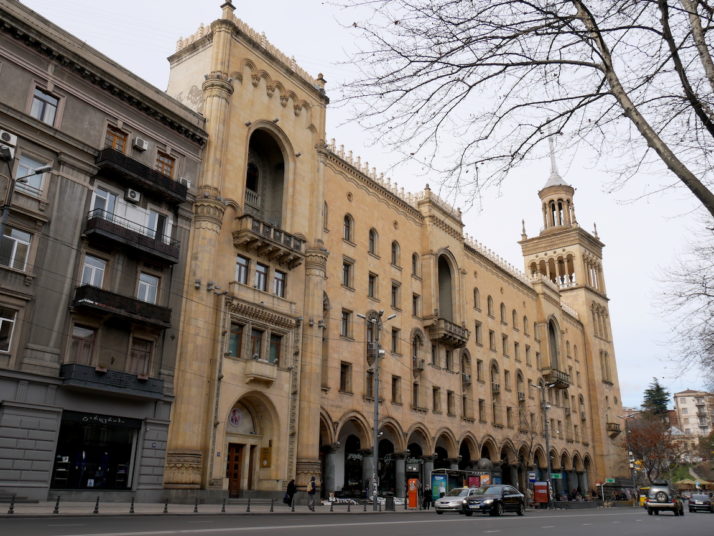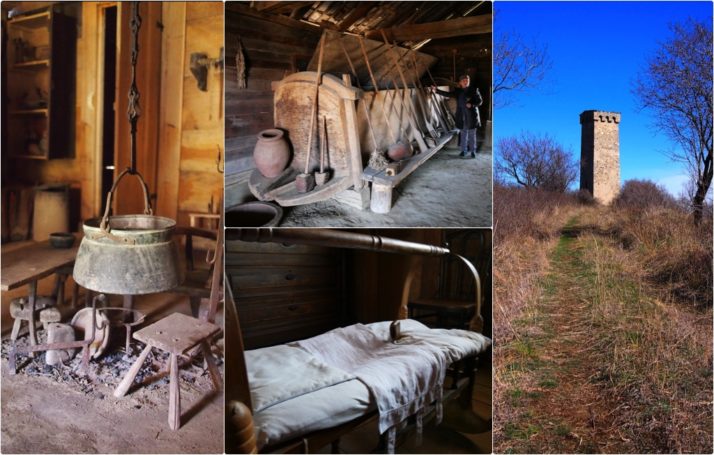Compared to Yerevan, Tbilisi feels more affluent and cosmopolitan, by that I mean there are more coffee shops, more restaurants (and chain restaurants), and a few more tourists, though that might have been because spring was on its way and it was getting warmer! Our great friend and travelling companion Jo flew in on the same day we crossed the border from Armenia to explore the capital and the country with us :o)
Rustaveli Avenue

This wonderfully imposing building is home to the Georgian National Academy of Sciences, and sits at the top of Rustaveli Avenue

At the other end of Rustaveli Avenue is the Georgian National Opera Theatre, a striking stand alone building in the Moorish Revival style

As well as the former parliament building, Rustaveli is lined with art such as these adorable little bonze figures made by different artists in the image of internationally famous people, can you guess any of them?
Old Town

A district of dilapidation awaits the ambler in Tbilisi’s Old Town

Encompassing the south-eastern part of the city, we loved just semi-aimlessly wandering through the organic street layout, admiring the picturesque dilapidation and stumbling on pretty little secluded public squares like this one with a romantic water fountain
Mtatsminda-Narikala Tourist Path – Funicular, Mother Georgia and Narikala Fortress

The Tbilisi Funicular railway started our half-day hike – we couldn’t stop ourselves taking panoramic photos of the city!

The Mtatsminda-Narikala Tourist Path. What a lovely day!

The giant Mother Georgia as vigilant and poised for defence as Armenia’s

Oh look.. another panoramic view of the city!

Not much remains of the Narikala Fortress but some of the outer walls have been restored and are good to climb up for yet more panoramic views of the city. We were surprised just how big the fortress is
Deserters’ Bazaar

Giant barrels of pickled vegetables, Julie’s favourite!

As we found in Armenia, the people are keen to know where we’re from and invite us to try their produce or take their photo

As well as stand after stand of fresh fruit and vegetables, and herbs and spices, we spotted laminated Christian icons and the odd sweet stall. Most of the locals sell their own “chacha” a homemade grappa-like spirit which we were encouraged to chase with pickled tomato
Chronicle of Georgia

The Chronicle of Georgia. A bit different to a church I suppose

Julie, Jo and I exploring the wackiness!
Sitting on the top of a hill near the city’s reservoir at the northern end of the metro line, it looks a lot like Stonehenge from a distance. We’d read that it’s by Georgian-Russian artist and sculptor Zurab Tsereteli whose works are often controversial, and that we’d seen one of his first public works – the giant Peter the Great Statue in the Moskva river in Moscow near the start of our adventures!
Open-Air Ethnographic Museum

Another lovely day to be outside exploring

The museum has a lovely mix of dwellings and tradesmans buildings spread out over a wooded hillside

Clockwise from left: a fireplace in a single room dwelling; a guide gives us an explanation of the grape press and the various cleaning and ladling tools; a distinctive tower house from the northern Svaneti region; and an example of the traditional “Georgian Pampers” for girls!
One invention I have to mention is a smoking pipe like wooden apparatus sticking up in the middle of a baby’s cot. The attendant dressed in period costume explained that the parents would hang a hollowed out gourd underneath the cot and “arrange” the child in such a way that they wouldn’t have to put them in nappies, they’d just strap them into the cot so they couldn’t move. With a slightly different design for boys and girls she finished her description by calling them “Georgian Pampers!”
Tsminda Sameba Cathedral

The gold-topped Holy Trinity Cathedral of Tbilisi in the golden evening light

 two year trip
two year trip